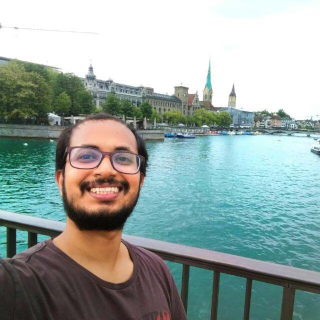
I am Himanshu
Ph.D. in Chemistry
Specialization - Electrochemistry
Masters - Engineering
Specialization - Nanotechnology

I am an electrochemist with a strong expertise in synthesis and characterization of nanomaterials.
During my Ph.D. thesis, I was focused on design and development of mesoporous materials for catalytic sensing applications.
If you wish to know more about my skills or expertise, You can connect with me via linkedin, researchgate or email.
Laboratoire de Chimie, Physique et Microbiologie pour les Matériaux et l’Environnement (LCPME)
UMR 7564, CNRS / Université de Lorraine, Nancy, FRANCE
“Functional 1D mesochannels for Electrochemical Sensors”
My research was focused on understanding the diffusion of molecules at mesoporous silica thin films and the electrocatalysis of molecules. I was motivated to conduct my doctoral research on this research domain due to my passion for understanding complex mechanisms taking place at the interfaces of materials. Electrochemistry allows to study these mechanisms with a high degree of precision while being relatively simpler to other methods.
Amity Institute of Nanotechnology
Amity University, Noida, INDIA
I did a dual-degree program in Nanotechnology with a focus on various methods and techniques required for research on various nanomaterials, their characterizations and different applications. The focus of the Masters was on biological applications of nanotechnology and the various aspects of research dealing with bio-inspired materials, molecular biology, drug delivery, etc.
Enterpreneurship Course
MOOC
General Raj's School, Delhi, India
Distinction with Honors. Subjects: English, Physics, Chemistry, Mathematics, Computer Sciences.
Laboratoire de Chimie, Physique et Microbiologie pour les Matériaux et l’Environnement (LCPME)
UMR 7564, CNRS / Université de Lorraine, Nancy, FRANCE
“Functional 1D mesochannels for Electrochemical Sensors”
The research focused on understanding the diffusion of molecules at mesoporous silica thin films and the electrocatalysis of molecules at electrodes coated with these films. The motivation behind this doctoral research was the passion to understand complex mechanisms taking place at the interfaces of materials. Electrochemistry allows for study of these catalytic mechanisms with a higher degree of precision while remaining relatively simpler to other methods.
Excellence Coaching Centre, New Delhi, India
I worked as a private tutor for High School Students
Subjects taught: Mathematics, Physics and Chemistry
Institute of Microstructure Technology
Karlsruhe Institute of Technology, Karlsruhe, GERMANY
The research focused on localization of metallic centers for controlled growth of Carbon Nanotubes using Electrochemical dip-pen nanolithography.
The techniques used were AFM (studying surface morphology in air and fluid mode, studying surface adhesion and dip-pen nanolithography) and optical microscopy.
Institute of Toxicology and Genetics
Karlsruhe Institute of Technology, Karlsruhe, GERMANY
The research was focused on synthesis of localized shape and size defined HKUST- 1 (Metal organic framework of Cu and benzene tricarboxylic acid) thin sheets using patterned superhydrophobic polymer surfaces. It included synthesis of the polymer surfaces, growth of HKUST-1 array, control of parameters, characterization using RAMAN spectroscopy, SEM, XRD, AFM, TEM and optical microscopy.
Department of Physics
Indian Institute of Technology, Delhi INDIA
The research work was fucused on synthesis of self-catalyzed Ga2O3 nanostructures on Si substrate using Chemical Vapor Deposition and its characterization using XRD, SEM and EDX.
The research tasks included were detailed analysis of the results and an evaluation of the responsible mechanism behind the growth of different nanostructures.
Department of Physics
Indian Institute of Technology, Delhi INDIA
The research work was focused on the synthesis of ZnO nanorods using chemical route and its characterization using XRD and SEM. This was follwed with a detialed analysis of the results.
Department - Physics and Astrophysics
Delhi University, Delhi INDIA
My responsibilities at this research project included synthesis of Si@Au core-shell nanoparticle composite and its characterization using DLS and UV-Vis spectroscopy.
School of Physical Sciences
Jawahal Lal Nehru University, Delhi INDIA
The target of this internship was to obtain a practical training on STM and AFM.
Micrography of different type of samples was done as part of this internship.
Department - Physics and Astrophysics
Delhi University, Delhi INDIA
The internship project focused on synthesis of Si membrane using wet etching process.
The tasks included development of silican membrane as a diaphram structure through lithography of silican wafer and it's subsequent etching using HF. The process included suitable cleaning of the silicon wafer, spin coating, masking, exposure with UV, development of the pattern and wet etching.
International Electrochemistry Conference, ElecNano8
I was the member of the organizing committee for biennial International electrochemistry conference, ElecNano8.
Spring Day
Doctoral School - Sesames
My poster titled “Cysteine oxidation mediated by ferrocene derivative at electrodes modified with mesoporous silica thin films” was awarded the first position on the doctoral day.
Delhi Commonwealth Games - 2010
MOOC
Volunteered during Delhi commonwealth games at the post of a protocol Assistant.
Amity University
Co-founder and active member of dramatics club "Awaaz" from 2009-2013. Organized several thetrical plays at inter-university competetions and cultural festivals.
General Raj's School
Awarded certification for highest score in Mathematics for consecutive 6 years.
The Energy and Research Initiative (TERI), India
First runner-up in the school at environmental quiz competetion organized by TERI, India.
Article
Himanshu Maheshwari, Neus Vilà, Grégoire Herzog, and Alain Walcarius.
Unmodified and ferrocene-functionalized mesoporous silica layers exhibiting vertical nanochannels have been grown through electrochemically assisted self-assembly onto indium-tin oxide (ITO), and the resulting film electrodes have been applied for the electrochemical detection of cysteine. When using the unmodified film electrode and ferrocenedimethanol (Fc(MeOH)2) as a mediator in solution, both cysteine and glutathione can be oxidized by the Fc(MeOH)2+ generated at the electrode surface, but the electron transfer rates were three times faster with cysteine than with glutathione. This can be exploited for the reagent-free selective detection of cysteine over glutathione by using a ferrocene-functionalized mesoporous silica film on an ITO electrode, based on a combination of charge transfer kinetic and mass transport limitations through the oriented nanochannels. This has been demonstrated here by using cyclic voltammetry and amperometry in flow-injection analysis mode. A sensitivity of 1.28 mA M−1 was measured for the cysteine concentration range of 3–20 μM with a repeatability of the signal between 3 and 12 %. The lowest concentration of cysteine experimentally detected was 3 μM.
Article
Tsotsalas, Manuel, Himanshu Maheshwari, Sophia Schmitt, Stefan Heißler, Wenqian Feng, and Pavel A. Levkin
Superhydrophobic–Superhydrophilic arrays are used to control the size and shape of freestanding metal–organic framework (MOF) microsheets. The MOF sheets are prepared at the liquid–liquid interface of an aqueous copper acetate solution confined in microdroplets and a 1-octanol solution of trimesic acid. The resulting MOF microsheets can be suspended in solution or transferred to other substrates.
Poster
Ferrocene-functionalized mesoporous silica layers exhibiting vertical nanochannels (~2.4 nm diameter) have been grown by electrochemically assisted selfassembly onto indium-tin oxide electrode. The resulting redox-active films have been applied to the electrochemical detection of cysteine in the presence of glutathione. The selectivity originates from a combination of charge transfer kinetics and mass transport limitations through the oriented nanochannels.
Oral Presentation
Poster
Here, we propose a method for detection of cysteine and glutathione using a ferrocene derivative, which electrochemically catalyses their oxidation. For this study, ferrocene derivative has been used free in solution as well as immobilized on silica mesoporous thin films. Vertically aligned mesoporous silica thin films display better selectivity and sensitivity (for cationic probes). Here, bare Indium Tin Oxide (ITO) and ITO films modified with vertically aligned mesoporous silica thin film (with and without immobilized ferrocene derivative) are used. The pores of the films are ~3nm in diameter and offer a highly selective surface for small molecules and with the possibility to functionalize this surface, it can be modified to further increase the sensitivity and detection limits. We discuss the electrochemical oxidation response for the various systems here.
Poster
Vertically aligned mesoporous silica thin films display better selectivity and sensitivity. The pores of the films are ~3nm in diameter and offer a highly selective surface for small molecules and with a possibility to functionalize the surface of these 1-dimentional nanochannels, it can be modified to further increase the sensitivity and detection limits. We discuss the electrochemical response of cysteine oxidation using ferrocene derivative as a mediator on these surfaces.

Use this area of the page to describe your project. The icon above is part of a free icon set by Flat Icons. On their website, you can download their free set with 16 icons, or you can purchase the entire set with 146 icons for only $12!




